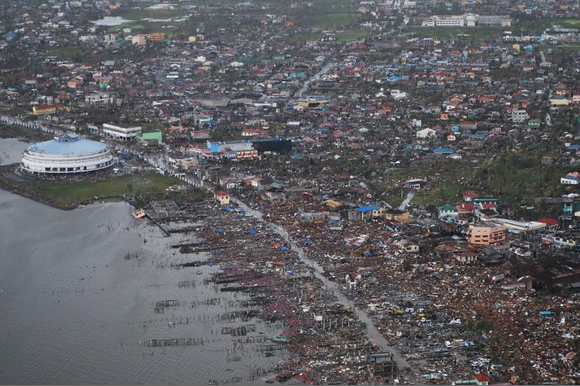The scale of destruction and death wrought by Typhoon Haiyan in the Philippines has kicked the international humanitarian disaster response system into gear. Despite huge logistic hurdles, including downed bridges, blocked roads and a non-function air traffic control tower, aid is starting to arrive at the hardest hit areas.
Here is what is going to happen next.
The United Nations will be at the center of this response, specifically the UN’s Office for the Coordination of Humanitarian Affairs (OCHA). This is a central hub for coordinating the work of agencies who respond to the discrete aspects of the emergency. Each of these agencies are responsible for different “clusters” including: Emergency Shelter; Water, Sanitation and Hygiene; Education; Logistics; Health; Camp Coordination; Nutrition; Protection of vulnerable populations; Restoring livelihoods; and Emergency Telecoms. For example: The World Food Program is in charge of food relief and logistics, UNICEF is in charge of sanitation, Habitat for Humanity is in charge of shelter, etc.
This is the basic system that has been in place since the 2004 Indian Ocean Tsunami, which provided an inflection point for the international humanitarian relief community to better organize itself. It was the system used following the Haiti earthquake and virtually every other manmade and natural disaster.
There are 22 agencies on the ground in the Philippines contributing to the international effort organized by the UN. Their initial estimate of the number of people affected by the typhoon is about 11.3 million, including over 600,000 displaced. They need an initial $301 million of funding mount a full response.
That money will overwhelmingly come from donor governments, though individuals do have an important role to play. (Annex III of the latest OCHA situation report lists these agencies and the specific projects they will undertake with donor funds). There are some stand-by emergency funds, but not a lot. These agencies are going to have to go hat-in-hand to donors to raise enough money to sustain their operations in the Philippines long after the crisis fades from international headlines. For now, though, these agencies are rushing to the scene of the devastation, setting up health clinics, building latrines, providing shelter, establishing internet and telecoms lines, and so on.
The international aid community is a very professionalized workforce. They know what they are doing, and how to do it. There are two key variables in whether or not they are able to mount a successful operation. The first is funding: are donors ponying up? Often times, these appeals reach less than 50% of the required funding, so medicine does not get purchased, shelters and latrines do not get built, leaving populations stranded.
The second variable is the level of cooperation and competency of the host government. When the government is a good, reliable local partner these operations go well. When the government tries to skim, profit, or otherwise obstruct the work of humanitarian agencies, that is when things get complicated.
The Philippines is a middle income country with a well developed civil service that theoretically should work well with international technical experts swooping in to manage the response. But it scores only 34 out of 100 on Transparency International’s corruption index, which is problematic. In the next few days we should have a good idea of how well Manila is working with aid agencies. We’ll also know how deep the international community is willing to dig into its pocket books.
For now, the situation on the ground is bleak, but thanks to a very well organized international system for responding to natural disasters it is not hopeless.
